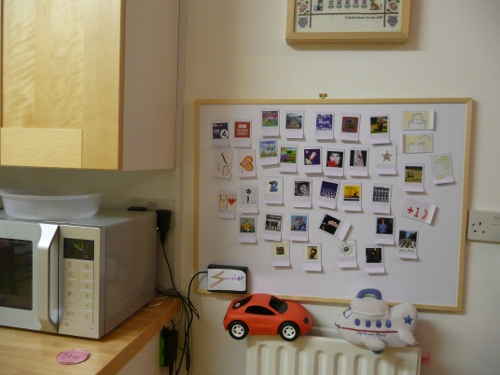Swisher is a fun way to play music at home.
You associate songs with physical cards and then wave them past a pad to play the song.
You can see it in use on this 30s video.
- To use it you need a 'driverless USB RFID 125khz reader' and some 125khz RFID cards
- It costs about £20 ($30) in total for a reader and 30 cards (postage can be quite slow and the price for the cards is very variable)
- You also need a PC and speakers
- It was created with a Raspberry Pi in mind but any Linux PC will do
- MPD/Mopidy - Swisher is an mpd client so you need a working mpd installation first. It also works with Mopidy an alternative mpd server which plays music from multiple sources.
- evdev - a linux kernel module which is usually already present (check you have the directory /dev/input)
> sudo apt-get install python-dev python-setuptools
> git clone https://github.com/thomasrynne/swisher.git
> cd swisher
> python setup.py install
> swisher
Go to http://localhost:3344 with a browser and you should see the swisher web page
The swisher webpage lets you search for tracks and albums and lists some radio stations. Search for a song and press play first to check that playing is working.
To associate cards with songs you press the zigzag button of the song and then swipe the card. After that swiping the card should play the song.
As well as songs, 'actions' can be associated with cards so you can make cards for stop/next/previous... See the /Actions page
There are many ways to use the physical cards. Here are some suggestions:
-
Stack of cards with song names written on sticky labels on the card
-
Stick pictures on the cards (for example album covers)
-
Put magnets on the card and keep the cards on a fridge or magnetic whiteboard
-
You can also bend the end of the cards in very hot water which makes it easier to take them of the whiteboard
-
Magnets intended for shower doors are cheap and the right strength
-
Cut round the antenna to make the cards smaller and stick them to toys
-
Hold the card against a bright light to see where the antenna is
-
Don't cut off the RFID chip which is usually a dot just outside the round antenna
-
You can also get keyring RFID tags. I have not tried these yet.
Please experiment yourself and let me know what works.
Driverless RFID readers behave like a usb keyboard and simulate typing in the card number when a card is waved as if it was entered through a keyboard. This means numbers get entered in the active terminal.
If you want to suppress this you can tell swisher which device is the rfid reader and it will grab and suppress the fake key presses.
Run "swisher --list-devices" before and after plugging in the USB RFID reader to see the name of your RFID reader. Then use the --grab-device argument or specify grab-device: 'name' in /etc/swisher.conf if you are using the init script (see below)
By default swisher connects to mpd on localhost 6600 You can change this with the mpd-host and mpd-port properties
By default the swisher web server listens on 3344 You can change this with the http-port property
> sudo cp misc/init.d.swisher /etc/init.d/swisher
> sudo cp misc/swisher.conf /etc
> sudo update-rc.d swisher defaults
Jamendo hosts free music for personal use. If you set the value jamendo-username: in the configuration file Jamendo pages are added to the swisher web page. You can use these pages to associate cards with tracks on Jamendo.
